OOP-实验二
实验任务一
源代码
T.h
点击查看代码
#pragma once
#include <string>
// 类T: 声明
class T {
// 对象属性、方法
public:
T(int x = 0, int y = 0); // 普通构造函数
T(const T &t); // 复制构造函数
T(T &&t); // 移动构造函数
~T(); // 析构函数
void adjust(int ratio); // 按系数成倍调整数据
void display() const; // 以(m1, m2)形式显示T类对象信息
private:
int m1, m2;
// 类属性、方法
public:
static int get_cnt(); // 显示当前T类对象总数
public:
static const std::string doc; // 类T的描述信息
static const int max_cnt; // 类T对象上限
private:
static int cnt; // 当前T类对象数目
// 类T友元函数声明
friend void func();
};
// 普通函数声明
void func();
T.cpp
点击查看代码
#include "T.h"
#include <iostream>
#include <string>
// 类T实现
// static成员数据类外初始化
const std::string T::doc{"a simple class sample"};
const int T::max_cnt = 999;
int T::cnt = 0;
// 类方法
int T::get_cnt() {
return cnt;
}
// 对象方法
T::T(int x, int y): m1{x}, m2{y} {
++cnt;
std::cout << "T constructor called.\n";
}
T::T(const T &t): m1{t.m1}, m2{t.m2} {
++cnt;
std::cout << "T copy constructor called.\n";
}
T::T(T &&t): m1{t.m1}, m2{t.m2} {
++cnt;
std::cout << "T move constructor called.\n";
}
T::~T() {
--cnt;
std::cout << "T destructor called.\n";
}
void T::adjust(int ratio) {
m1 *= ratio;
m2 *= ratio;
}
void T::display() const {
std::cout << "(" << m1 << ", " << m2 << ")" ;
}
// 普通函数实现
void func() {
T t5(42);
t5.m2 = 2049;
std::cout << "t5 = "; t5.display(); std::cout << '\n';
}
task1.cpp
点击查看代码
#include "T.h"
#include <iostream>
void test_T();
int main() {
std::cout << "test Class T: \n";
test_T();
std::cout << "\ntest friend func: \n";
func();
}
void test_T() {
using std::cout;
using std::endl;
cout << "T info: " << T::doc << endl;
cout << "T objects'max count: " << T::max_cnt << endl;
cout << "T objects'current count: " << T::get_cnt() << endl << endl;
T t1;
cout << "t1 = "; t1.display(); cout << endl;
T t2(3, 4);
cout << "t2 = "; t2.display(); cout << endl;
T t3(t2);
t3.adjust(2);
cout << "t3 = "; t3.display(); cout << endl;
T t4(std::move(t2));
cout << "t4 = "; t4.display(); cout << endl;
cout << "test: T objects'current count: " << T::get_cnt() << endl;
}
运行结果
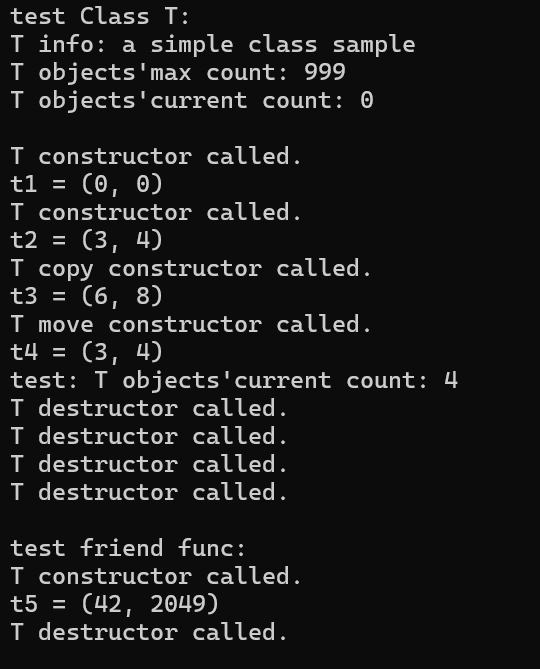
实验总结
1.NO,在作用域内未声明func函数, 因为 func() 是类外定义的友元函数,必须先声明

2.T(int x = 0, int y = 0);是普通构造函数;创建新对象时初始化数据成员;在T obj; 或 T obj(1,2); 创建新对象时调用
T(const T &t);是复制构造函数;用已有对象创建新对象;在T obj2 = obj1; 或函数传值参数时调用
T(T &&t);是移动构造函数;转移资源所有权;在T obj2 = std::move(obj1); 或返回临时对象时调用
~T();是析构函数;清理对象资源,释放内存;在对象离开作用域或被delete时自动调用
3.NO,static成员在类中只是声明,需要单独初始化,如果将这些初始化语句从T.cpp移到T.h中,会导致重复定义错误

实验任务二
源代码
Complex.h
点击查看代码
#include <iostream>
#include <string>
using namespace std;
class Complex
{
private:
double real;
double imag;
public:
static const string doc;
Complex (double r = 0.0, double i = 0.0);
Complex (const Complex &c);
double get_real() const;
double get_imag() const;
void add (const Complex &c);
friend double output (const Complex &c);
friend double abs (const Complex &c);
friend bool is_equal (const Complex &c1, const Complex &c2);
friend Complex add (const Complex &c1, const Complex &c2);
friend bool is_not_equal (const Complex &c1, const Complex &c2);
~Complex();
};
Complex.cpp
点击查看代码
#include "Complex.h"
#include <cmath>
const string Complex::doc = " a simplified complex class";
Complex::Complex(double r, double i) : real(r), imag(i) {}
Complex::Complex(const Complex &c) : real(c.real), imag(c.imag) {}
double Complex::get_real() const {
return real;
}
double Complex::get_imag() const {
return imag;
}
void Complex::add(const Complex &c) {
real += c.real;
imag += c.imag;
}
double output(const Complex &c) {
if (c.imag >= 0)
std::cout << c.real << " + " << c.imag << "i";
else
std::cout << c.real << " - " << -c.imag << "i";
return 0.0;
}
double abs(const Complex &c) {
return std::sqrt(c.real * c.real + c.imag * c.imag);
}
bool is_equal(const Complex &c1, const Complex &c2) {
return (c1.real == c2.real) && (c1.imag == c2.imag);
}
Complex add(const Complex &c1, const Complex &c2) {
return Complex(c1.real + c2.real, c1.imag + c2.imag);
}
bool is_not_equal(const Complex &c1, const Complex &c2) {
return !is_equal(c1, c2);
}
Complex::~Complex() {}
task2.cpp
// 待补足头文件
// xxx
#include "Complex.h"
#include <iostream>
#include <iomanip>
#include <complex>
void test_Complex();
void test_std_complex();
int main() {
std::cout << "*******测试1: 自定义类Complex*******\n";
test_Complex();
std::cout << "\n*******测试2: 标准库模板类complex*******\n";
test_std_complex();
}
void test_Complex() {
using std::cout;
using std::endl;
using std::boolalpha;
cout << "类成员测试: " << endl;
cout << Complex::doc << endl << endl;
cout << "Complex对象测试: " << endl;
Complex c1;
Complex c2(3, -4);
Complex c3(c2);
Complex c4 = c2;
const Complex c5(3.5);
cout << "c1 = "; output(c1); cout << endl;
cout << "c2 = "; output(c2); cout << endl;
cout << "c3 = "; output(c3); cout << endl;
cout << "c4 = "; output(c4); cout << endl;
cout << "c5.real = " << c5.get_real()
<< ", c5.imag = " << c5.get_imag() << endl << endl;
cout << "复数运算测试: " << endl;
cout << "abs(c2) = " << abs(c2) << endl;
c1.add(c2);
cout << "c1 += c2, c1 = "; output(c1); cout << endl;
cout << boolalpha;
cout << "c1 == c2 : " << is_equal(c1, c2) << endl;
cout << "c1 != c2 : " << is_not_equal(c1, c2) << endl;
c4 = add(c2, c3);
cout << "c4 = c2 + c3, c4 = "; output(c4); cout << endl;
}
void test_std_complex() {
using std::cout;
using std::endl;
using std::boolalpha;
cout << "std::complex<double>对象测试: " << endl;
std::complex<double> c1;
std::complex<double> c2(3, -4);
std::complex<double> c3(c2);
std::complex<double> c4 = c2;
const std::complex<double> c5(3.5);
cout << "c1 = " << c1 << endl;
cout << "c2 = " << c2 << endl;
cout << "c3 = " << c3 << endl;
cout << "c4 = " << c4 << endl;
cout << "c5.real = " << c5.real()
<< ", c5.imag = " << c5.imag() << endl << endl;
cout << "复数运算测试: " << endl;
cout << "abs(c2) = " << abs(c2) << endl;
c1 += c2;
cout << "c1 += c2, c1 = " << c1 << endl;
cout << boolalpha;
cout << "c1 == c2 : " << (c1 == c2)<< endl;
cout << "c1 != c2 : " << (c1 != c2) << endl;
c4 = c2 + c3;
cout << "c4 = c2 + c3, c4 = " << c4 << endl;
}
运行结果
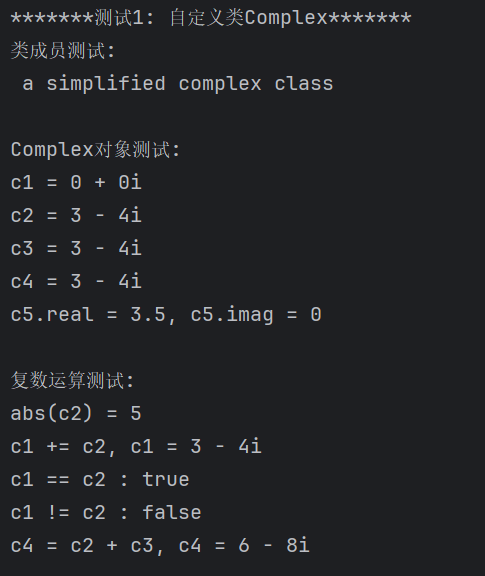
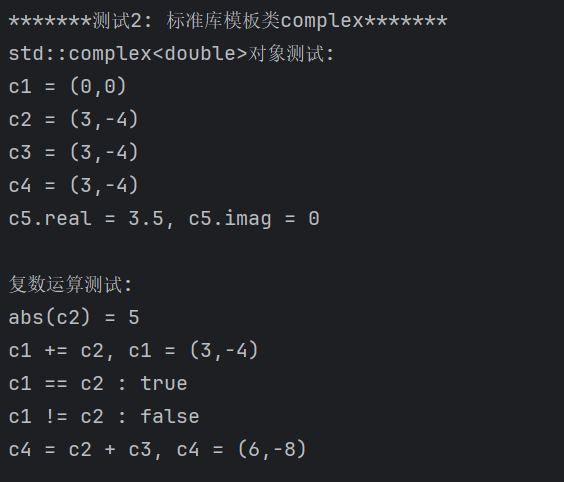
实验结论
1.标准库模板类complex更简洁
2-1.是,因为这些函数需要直接访问复数的实部和虚部私有数据
2-2.否,标准库 std::complex 没有将 abs 设为友元,因为可以通过公有接口 real() 和 imag() 访问数据
2-3.需要非成员函数访问私有数据时
3.将拷贝构造函数声明为 explicit 或删除拷贝构造函数
实验任务3
源代码
PlayerControl.h
点击查看代码
#pragma once
#include <string>
enum class ControlType {Play, Pause, Next, Prev, Stop, Unknown};
class PlayerControl {
public:
PlayerControl();
ControlType parse(const std::string& control_str); // 实现std::string --> ControlType转换
void execute(ControlType cmd) const; // 执行控制操作(以打印输出模拟)
static int get_cnt();
private:
static int total_cnt;
};
PlayerControl.cpp
点击查看代码
#include "PlayerControl.h"
#include <iostream>
#include <algorithm>
int PlayerControl::total_cnt = 0;
PlayerControl::PlayerControl() {}
// 待补足
// 1. 将输入字符串转为小写,实现大小写不敏感
// 2. 匹配"play"/"pause"/"next"/"prev"/"stop"并返回对应枚举
// 3. 未匹配的字符串返回ControlType::Unknown
// 4. 每次成功调用parse时递增total_cnt
ControlType PlayerControl::parse(const std::string& control_str) {
std::string lower_str = control_str;
std::transform(lower_str.begin(), lower_str.end(), lower_str.begin(), ::tolower);
if (lower_str == "play") {
total_cnt++;
return ControlType::Play;
}
else if (lower_str == "pause") {
total_cnt++;
return ControlType::Pause;
}
else if (lower_str == "next") {
total_cnt++;
return ControlType::Next;
}
else if (lower_str == "prev") {
total_cnt++;
return ControlType::Prev;
}
else if (lower_str == "stop") {
total_cnt++;
return ControlType::Stop;
}
return ControlType::Unknown;
}
void PlayerControl::execute(ControlType cmd) const {
switch (cmd) {
case ControlType::Play: std::cout << "[play] Playing music...\n"; break;
case ControlType::Pause: std::cout << "[Pause] Music paused\n"; break;
case ControlType::Next: std::cout << "[Next] Skipping to next track\n"; break;
case ControlType::Prev: std::cout << "[Prev] Back to previous track\n"; break;
case ControlType::Stop: std::cout << "[Stop] Music stopped\n"; break;
default: std::cout << "[Error] unknown control\n"; break;
}
}
int PlayerControl::get_cnt() {
return total_cnt;
}
task3.cpp
点击查看代码
#include "PlayerControl.h"
#include <iostream>
void test() {
PlayerControl controller;
std::string control_str;
std::cout << "Enter Control: (play/pause/next/prev/stop/quit):\n";
while(std::cin >> control_str) {
if(control_str == "quit")
break;
ControlType cmd = controller.parse(control_str);
controller.execute(cmd);
std::cout << "Current Player control: " << PlayerControl::get_cnt() << "\n\n";
}
}
int main() {
test();
}
运行结果
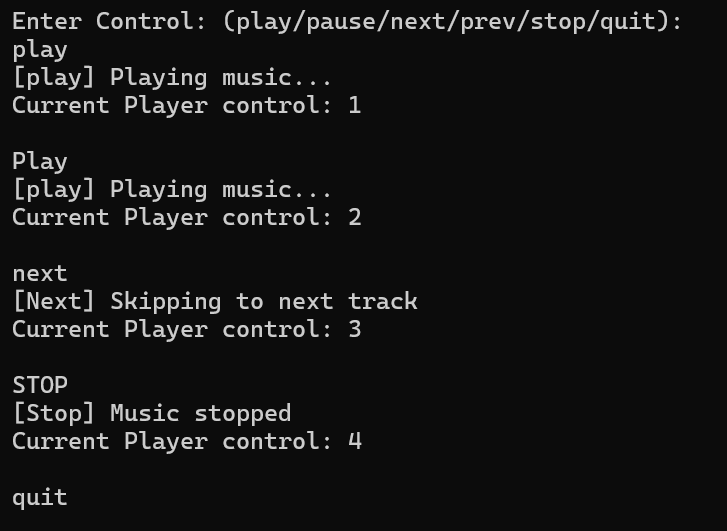
实验任务4
源代码
Fraction.h
点击查看代码
#include <iostream>
#include <string>
using namespace std;
class Fraction
{
private:
int up,down;
public:
static const std::string doc;
Fraction(int u = 0, int d = 1);
Fraction(const Fraction& f);
int get_up() const;
int get_down() const;
Fraction negative() const;
friend void output(const Fraction& f);
friend Fraction add(const Fraction& f1, const Fraction& f2);
friend Fraction sub(const Fraction& f1, const Fraction& f2);
friend Fraction mul(const Fraction& f1, const Fraction& f2);
friend Fraction div(const Fraction& f1, const Fraction& f2);
~Fraction();
};
Fraction.cpp
点击查看代码
#include "Fraction.h"
#include <bits/stdc++.h>
const std::string Fraction::doc = "Fraction类 v 0.01版. \n目前仅支持分数对象的构造、输出、加/减/乘/除运算.";
Fraction::Fraction(int u, int d) : up(u), down(d) {
}
Fraction::Fraction(const Fraction& f) : up(f.up), down(f.down) {}
int Fraction::get_up() const {
return up;
}
int Fraction::get_down() const {
return down;
}
Fraction Fraction::negative() const {
return Fraction(-up, down);
}
void output(const Fraction& f) {
int up = f.get_up(),down = f.get_down();
if(down == 0) {
cout << "分母不能为0!";
}else
{
if (down < 0)
{
up = -up;
down = -down;
}
int x = __gcd(abs(up), abs(down));
up /= x;
down /= x;
if(up == 0) cout<<"0";
else if(down == 1) cout<<up;
else cout << up << "/" << down;
}
}
Fraction add(const Fraction& f1, const Fraction& f2) {
return Fraction(f1.get_up() * f2.get_down() + f2.get_up() * f1.get_down(),
f1.get_down() * f2.get_down());
}
Fraction sub(const Fraction& f1, const Fraction& f2) {
return Fraction(f1.get_up() * f2.get_down() - f2.get_up() * f1.get_down(),
f1.get_down() * f2.get_down());
}
Fraction mul(const Fraction& f1, const Fraction& f2) {
return Fraction(f1.get_up() * f2.get_up(), f1.get_down() * f2.get_down());
}
Fraction div(const Fraction& f1, const Fraction& f2) {
return Fraction(f1.get_up() * f2.get_down(), f1.get_down() * f2.get_up());
}
Fraction::~Fraction() {}
task4.cpp
点击查看代码
#include "Fraction.h"
#include <iostream>
void test1();
void test2();
int main() {
std::cout << "测试1: Fraction类基础功能测试\n";
test1();
std::cout << "\n测试2: 分母为0测试: \n";
test2();
}
void test1() {
using std::cout;
using std::endl;
cout << "Fraction类测试: " << endl;
cout << Fraction::doc << endl << endl;
Fraction f1(5);
Fraction f2(3, -4), f3(-18, 12);
Fraction f4(f3);
cout << "f1 = "; output(f1); cout << endl;
cout << "f2 = "; output(f2); cout << endl;
cout << "f3 = "; output(f3); cout << endl;
cout << "f4 = "; output(f4); cout << endl;
const Fraction f5(f4.negative());
cout << "f5 = "; output(f5); cout << endl;
cout << "f5.get_up() = " << f5.get_up()
<< ", f5.get_down() = " << f5.get_down() << endl;
cout << "f1 + f2 = "; output(add(f1, f2)); cout << endl;
cout << "f1 - f2 = "; output(sub(f1, f2)); cout << endl;
cout << "f1 * f2 = "; output(mul(f1, f2)); cout << endl;
cout << "f1 / f2 = "; output(div(f1, f2)); cout << endl;
cout << "f4 + f5 = "; output(add(f4, f5)); cout << endl;
}
void test2() {
using std::cout;
using std::endl;
Fraction f6(42, 55), f7(0, 3);
cout << "f6 = "; output(f6); cout << endl;
cout << "f7 = "; output(f7); cout << endl;
cout << "f6 / f7 = "; output(div(f6, f7)); cout << endl;
}
运行结果
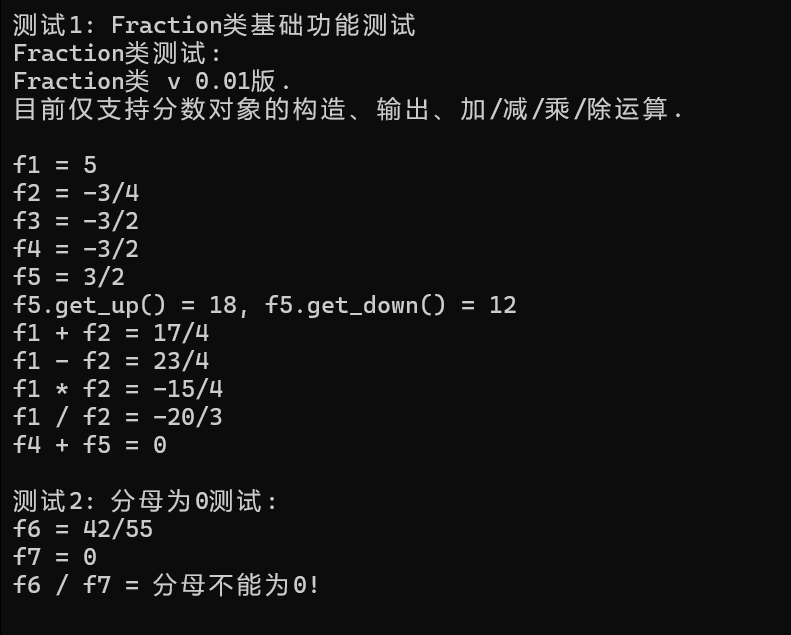
实验结论
我选择的友元,因为友元函数可以直接访问函数的私有变量,方便对分数进行化简,同时由于友元函数可以访问私有成员,所以安全性有所降低。




 浙公网安备 33010602011771号
浙公网安备 33010602011771号